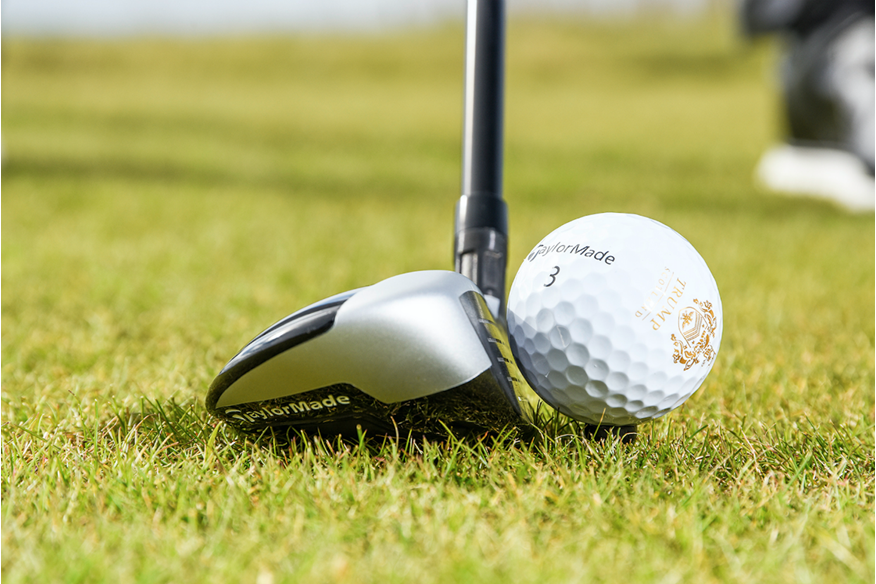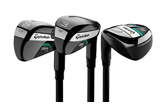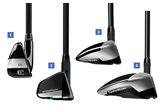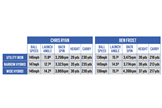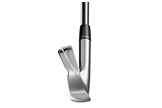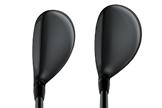How to choose a new hybrid
Last updated:
Never use your 4-iron? Hybrid go as far as your 5-wood? Then read this…
We’ve all boomed a drive down the middle on a tough par 4, only to stroll to our ball and realise there’s 200 yards left to the flag. Fifteen years ago, we’d need to get out a 3 or 4 iron and pray the shots got airborne. And if it did, we’d be willing it to stay in the air long enough to carry any hazards between us and the flag!
For any shots that did make it into the air, the chance of stopping them on the green were slim, because they span so little and flew so low. Fortunately, that’s all changed as hybrids and easier-to-hit utility clubs have convinced many golfers to ditch long irons. Hybrids make it easier to flight long shots from the turf, but they also dramatically improve your chances of stopping shots closer to the flag, and improve accuracy.
But how do you choose between high-lofted fairway woods, wide and narrow body hybrids and utility style irons, all of which can have the same loft? To make your best selection you need a decent understanding of your game, what you’re trying to achieve from 200ish yards out and, crucially, have a knowledge of how the options differ.
#1: DO I CHOOSE A HIGH-LOFTED FAIRWAY WOOD, HYBRID OR UTILITY IRON?
1. Utility Or Driving Iron
Typically suited to: Above-average swing speeds
Utility irons are massively popular on tour because they give hard-hitting pros control over spin and launch, which is down to the narrower soles (the centre of gravity is closer to the face) and heavier shafts being much more closely matched to a set of irons. Think of the best as offering the ball speed of a hybrid, but lower spin like an iron.
A recent TG test found comparing utility irons with wide body hybrids of the same loft, that the irons flighted shots 10 yards lower with 600rpm less backspin. That says they can be perfect for lowering ball flight and increasing control.
Choose one because: You like the look of irons over hybrids or fairways and have no di culty launching long irons from the tee and turf. You’re probably also on the lookout for extra ball speed (which is down to their hollow heads).
2. Narrow-Body Hybrid
Typically suited to: Mid to fast swing speeds
Club designers talk time and again about how their narrow-body hybrids have a more neutral bias, which is less likely to go left – a very different set-up to wider body models. These narrower heads usually spin less, so shots tend to be more penetrating, offering skilled golfers the ability to control shots, particularly in the wind when high “floaty” hybrids can be a menace. Longer hosels (like irons), heavier shafts and more compact heads tend to be more closely matched to a set of irons.
Choose one because: You like hitting hybrids for long approaches (think about par-3 performance, too) but want a lower spinning, lower-flighted, more controllable ball flight than wide-body models offer. Logic says you’ll probably tend to hit down on hybrids and engage the turf like hitting irons, too.
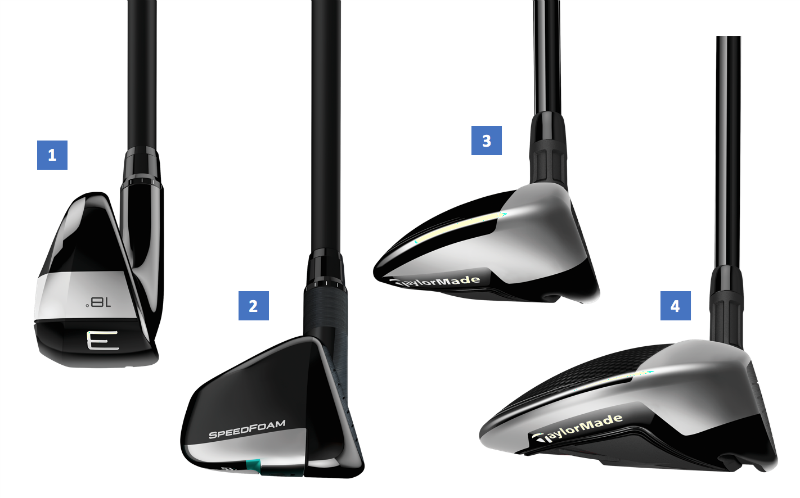
3. Mid/Wide-Body Hybrid
Typically suited to: Slow to mid swing speeds
Exactly the same principles as high- lofted fairway woods. The wider head makes it easy to flight shots from the turf and is particularly good in the hands of golfers who don’t create enough spin to keep shots in the air to maximise carry distance. Shaft weights are often lighter like fairway woods, and shorter hosels (more like a fairway wood) mean more weight to distribute to improve forgiveness. When we compared wide and narrow hybrids for the first time last year, our test pro said the vast majority of club golfers would be best off with a wide-headed hybrid.
Choose one because:
You prefer the look of a hybrid over a fairway for anything other than the longest approaches. Your average swing speed probably means you need a bit of help (more spin) flighting shots to get max carry.
4. High Loft Fairway
Typically suited to: Slow to mid swing speeds
Their wider (from face to back), generally larger heads mean the centre of gravity is further from the face. The wider body and a lighter shaft weight (generally) generates more spin, so typically shots launch higher with a more looping flight. Forgiveness (or MOI performance) and ball speed protection is improved because the centre of gravity is positioned further back so the head twists less when hit off-centre. Leading brands offer 9 and 11-wood lofts which can legitimately replace a 5-iron.
Choose one because:
You find bigger heads increase confidence and you like hitting fairway woods more than hybrids or long irons from the turf. You’ve also probably got a shallower attack angle that can sweep woods off the turf, rather than engaging the turf and taking a divot (like a iron).
#2: ARE HYBRIDS MORE ACCURATE THAN IRONS?
It’s a very valid question, and not quite as easy to answer definitively as you might think. The experts at Shot Scope – the watch-based shot-tracking GPS device – dived into their database to tell us golfers who hit hybrids from 180-200 yards are 29% more likely to hit the green than those who use long irons. And that number drastically improves to 71% for approaches from 200-220 yards out.
It’s lovely insight, and obviously favours hybrids, but it doesn’t quite tell the whole story. That’s because we’ve also spoken to a number of fitters who tell us they often see golfers hit long irons into a tighter dispersion circle than hybrids. They say the shorter shaft length offers more control, and as long as you have the downward attack angle and enough club speed to launch long irons into the air, and you’re happy to do so, they’re happier seeing more golfers use long irons.
We reckon there’s a couple of factors at play here. Fitters see golfers on a range where they don’t need to account for water hazards, bunkers, OB, the wind or the state of a card coming down the stretch; whereas shot trackers record data for every shot hit. You can’t delete those you don’t like, as you can on a launch monitor. It means Shot Scope’s data more accurately reflects what really happens on the course.
At the end of the day we’d say it boils down to confidence, and how you feel personally about standing over a long iron. But be open-minded to what’s out there, too.
Equipment Editor Simon Daddow – who’s a massive hybrid fan – was adamant he couldn’t hit a 5-iron more than a few yards further than his 6 (from the turf), until PXG fitter Matt Straughan convinced him to try their 24° (#5) X driving iron. After having absolutely no difficulty launching shots from the turf, and hitting balls into a brilliant six-yard dispersion circle, Simon soon changed his mind…

#3: WHATS THE DIFFERENCE IN PERFORMANCE BETWEEN NARROW AND WIDE BODIES
Wide Body: Spins more, launches and flies higher and great for protecting ball speed. Typically more draw bias than narrow bodies.
Narrow Body: Tends to have a centre of gravity more towards the toe to guard against shots going left. Spins less and flies lower.
Successful hybrid selection requires you know at least a little bit about how wide and narrow body models perform against utility-style long irons. We’ve run a couple of recent tests where we set each club up with the same amount of loft, but with two different TG test pros (Chris Ryan and Ben Frost) to reveal how each differs in terms of data.
Remember, numbers will differ for everyone, but one of our test pros saw a 20 per cent increase in launch angle switching from a utility long iron to a wide-body hybrid. That equated to an extra 10 yards of height (and six yards of carry distance), which really helps when it comes to stopping shots on a green.
Both testers recorded their highest backspin and carry distance with wide-body hybrids, which says that if you’re looking for the friendliest, easiest and longest option available, wide hybrids have lots going for them.
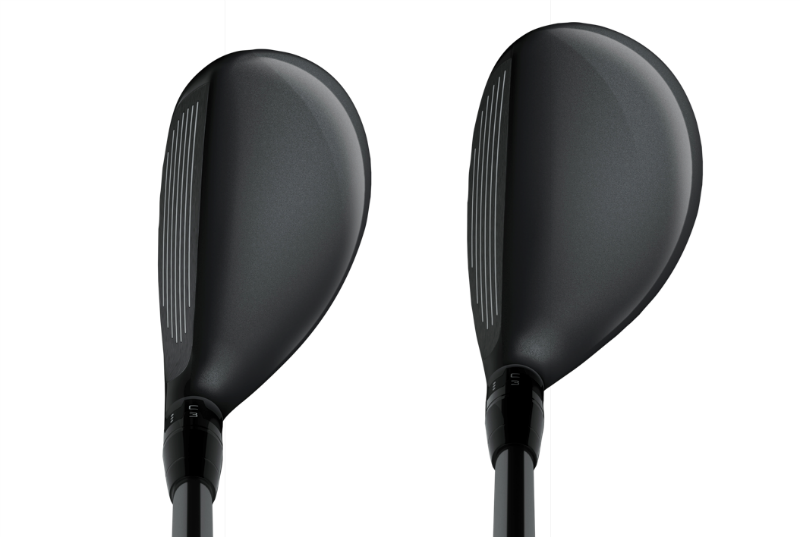
#4: WHY DON’T MORE TOUR PROS USE HYBRIDS?
As hybrids took off they were seen as wonder clubs that could really fix any golfer’s long game and banish those difficult-to-hit long irons to Room 101. Padraig Harrington won three Majors with Wilson hybrids in his bag; Todd Hamilton chipped his way around Royal Troon with a Sonartec hybrid to lift the 2004 Open; and YE Yang beat Tiger to a US PGA Championship with two hybrids in his bag…
But while they’ve really taken off with club golfers, the same can’t be said on tour. Jordan Spieth (below) is the only player in the world’s top 10 to carry a hybrid on a regular basis (a 21° Titleist 818 H2), while just four players inside the top 20 play a long iron replacement – Alex Noren (18° Callaway Apex); Paul Casey (21° TaylorMade M3); Webb Simpson (18° Titleist 913 HD); and Hideki Matsuyama (19° Honma Tour World).
Why? Hybrids are very player-dependant, and that’s backed up in the women’s game. There are plenty of professional golfers carrying some of the best ladies’ hybrids, including World No.1 Ariya Jutanugarn carries both #2 and #3 TaylorMade driving irons, whereas Michelle Wie – who we think of as a power player – has four fairway woods in her bag (15°, 19°, 21° and 25° lofts) and only uses 6-iron down! That suggests the top end of a golfer’s bag is a highly personal make-up, and spells out how important it is to get fitted when it comes to filling those gaps between fairway woods, hybrids and irons.
#5: DON’T BECOME THE VICTIM OF LOFT
If you’ve bought a new set of irons (from 5-PW) over the last five years, there’s a chance you’ll have a “4-iron” iron in your bag without knowing it… even though the longest iron has a 5 on the sole. Iron lofts have got stronger over the years as manufacturers have milked every last drop of ball speed and carry distance out of new designs. In fact, lofts have become so strong that some 5-irons actually have the same loft you’d expect to find on a 4-iron from a few years ago. Mizuno backed up the thinking by comparing long iron lofts from 15 years ago against their latest JPX919 Hot Metal irons…
What does it mean to you?
Just be aware when getting fitted that you probably won’t be able to hit the long irons from your new set on the day (pros will often use a 6- or 7-iron and won’t have the long irons in stock). If you can buy individual irons (that’s how Ping, Mizuno and Titleist sell theirs), just buy to the number you know you’re con dent using. Above that look at exploring wider-soled, hollow-body utility irons. They offer more forgiveness and are easier to flight, and you should be able to try them on a fitting day – turn over to see our pick of the best hybrids and utility irons of 2018. 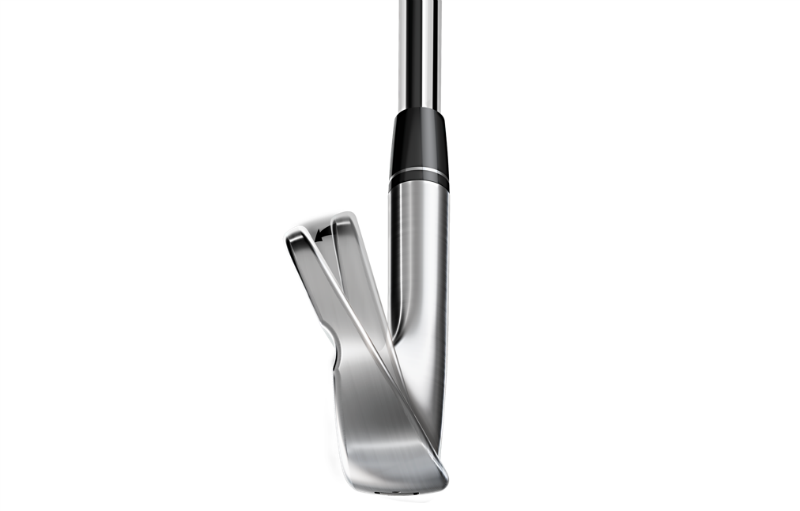
#6: WHAT ABOUT COBRA’S ONE LENGTH HYBRIDS?
The idea sounds bonkers when Cobra pulled the covers of its King F8 One Length hybrid. But Cobra insist the wider sole launches shots higher than a traditional 4-iron, but with the same level of control, consistency and confidence you expect from a typical 7-iron.
Admittedly, standing over a hybrid the length of a 7-iron is a bit weird; it’s like playing with child’s clubs. Initially, we thinned shots, struggling to get such a short-shafted club down to the bottom of the ball. But TG Equipment editor Simon was intrigued enough to keep going and within half-a-basket of balls, had shots pinging higher into the air with more consistency than he’d ever expect from a 5 or 4 iron from the deck. This, says Cobra, is thanks to how the One Length hybrid has a centre of gravity 3.4mm lower and 3.5mm further back from the face than a typical 4-iron, which is substantial in terms of playability.
We certainly aren’t saying One Length hybrids are for everyone. They aren’t. If you have no issue launching and flighting a 5-iron from the turf, move along now, there’s nothing more to see here. But if you do struggle, or have the sensation you need your Sunday best swing to get a 4- or 5-iron airborne the King F8 One Length is seriously worth a look.
#7: WHERE DOES TAYLORMADE’S GAPR FIT IN?
GAPR only launched in July (and went on sale in September) and it’s a new way of thinking about the top end of your bag.
TaylorMade invented the hybrid category as we know it when they introduced Rescues back in 2003, so they’ve got pedigree when it comes to recognising gaps in the market. TaylorMade are adamant GAPR is not replacing the current M3 or M4 hybrids, nor their P790 Ultimate Driving Iron.
Instead, it’s a whole new category – a system, with three different clubs (Hi, Lo and Mid) to allow complete customisation of how golfers fill gaps between their most lofted fairway wood and the longest iron they hit with any confidence. You’ve got to delve deep into the specs to really see where it fits in. Comparing GAPR against the M4 Rescue, for instance, GAPR Hi has a smaller head (91cc vs 100cc), and a heavier stock shaft with a lower torque rating – all traits of ranges aimed at above-average golfers.
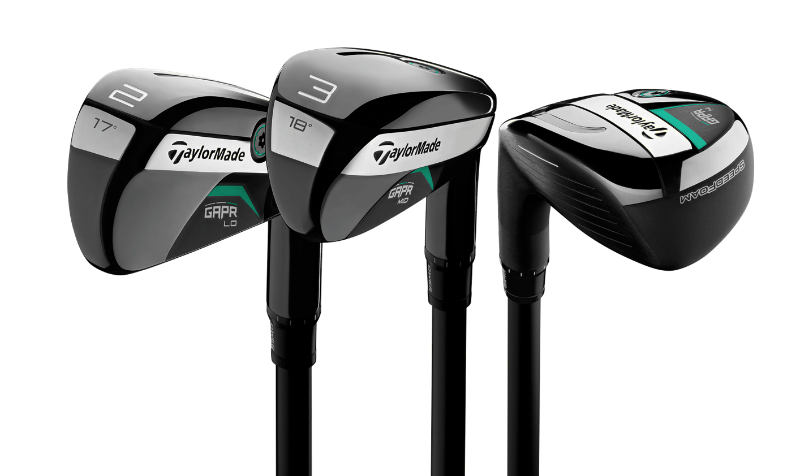
Our testing has shown M4 can out-do GAPR Hi when it comes to ball speed (by 2mph), but the latter flighted shots five yards higher for our test pro, even though they carried the same distance.
The most telling stat, though, is how M4 span a little less, which tells us that’s more of a distance machine whereas GAPR Hi, alongside the Mid and Lo, is a much more tuneable fitting tool. Plenty of decent players complain of hitting wide-body hybrids left, so they often choose utility long irons instead. We reckon that’s exactly who GAPR has been developed for – above-average players who’ve never quite found their mojo with hybrids.
#8: WHAT ELSE SHOULD I REMEMBER BEFORE GETTING FITTED FOR A NEW HYBRID?
Give me data
You really need to get on a launch monitor which gives clubhead as well as ball data, as you need to know a bit about your angle of attack to choose the ideal club. Steeper angles of attack when accompanied with speed are often suited to utility, driving -style irons and narrower hybrids, whereas shallower angles of attack often get more out of wider body models.
Be honest
Be really honest with yourself about which is the longest iron you hit with any confidence. For Equipment Editor Simon Daddow it’s a six, but for some maybe a 5-, 7- or even 8-iron. There are hybrids out there to fill any gap in your bag, and by doing so they make the game easier –and more fun.
Hit, hit, hit
If a fitter only wants to see you hit shots with a hybrid, they’ll have no idea of the distance gaps in your own game. It’s not enough just to ask how far you hit your highest-lofted fairway and longest iron – you must hit both on a launch monitor to establish how big the gap is that needs filling. Our experience is that reality is very different compared to how far we think we hit shots.
Brush up on your knowledge
Have an idea of the different categories or types of hybrids available, and give some thought to where you typically want to use a hybrid. Make the right choice and a hybrid can become a firm favourite on the golf course. For us; versatility is key – get it right and you’ll be able to clip shots out of fairway bunkers, chip with it, dig shots out of rough and have a reliable club on long par 3s – things you’d never say about a 4-iron.
